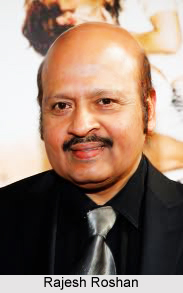 Rajesh Roshan is the Indian music composer whose works or compositions have shown his talents in the respective fields. Rajesh Roshan is the accredited director whose compositions are landmarks in the boulevard of pictures.
Rajesh Roshan is the Indian music composer whose works or compositions have shown his talents in the respective fields. Rajesh Roshan is the accredited director whose compositions are landmarks in the boulevard of pictures.
Early Life of Rajesh Roshan
Rajesh Roshan Lal Nagrath was born on 24 May 1955 in Mumbai, burdened by the cross of an celebrated father`s work is no mean task, but Rajesh Roshan is made of sterner stuff. The composer has managed to come into sight from his successful father`s silhouette and carve a niche for himself in film music. Right from his first film, to sporadic instances of failure, to his remarkable comeback, Rajesh Roshan has never once flinched. His mammoth return with Kaho Naa Pyaar Hai has goes to show that Rajesh Roshan will never run out of steam.
Thirty years ago, there were three music directors who had established a stronghold so tough that no other composer - new or old - could break through their monopoly. But proving the axiom that one can`t really stop a real talent Rajesh Roshan, younger son of the late genius Roshan, broke through into this elite RD Burman / Kalyanji-Anandji / Laxmikant-Pyarelal League with Mehmood`s Kunwara Baap. With his very first film, Rajesh Roshan topped the annual Binaca Geet Mala, the only countdown show of the time, with `Saj Rahi Gali..`, the hijra song sung by Mohammed Rafi, `Main Hoon Ghoda Yeh Hai Gaadi..`, `Jai Bholenath Jai Ho Prabhu..` and `Aa Ri Aaja Nindiya..` added to what was virtually an all-hit score.
The most refreshing feature of his songs was that Rajesh`s musical idiom was totally different from that of any other music composer, which included dad Roshan and Laxmikant-Pyarelal, under whom he had learnt his practical ropes. His second release was Julie (1975), produced by B. Nagi Reddy, the man who had been Columbus to his actor-brother Rakesh. This all-hit score bagged Rajesh Roshan his first Film-Fare award. `Dil Kya Kare Jab Kisise.` sung by Kishore Kumar, became an instant hit and it created a wave of fresh love songs. Other nuggets from the film included `Yeh Raaten Nayi Purani.`, `My Heart Is Beating..`and `Julie, I love you..`
Between then and 1982, Rajesh Roshan went from strength to strength with scores as varied, refreshing and, above all, individualistic, as Swami, Priyatama, Doosara Aadmi, Inkaar (all 1977), Khatta Meetha and Des Pardes (1978), Mr. Natwarlal (1979), Swayamwar (1980), Yaarana (1981), Khuddar and Kaamchor (1982). Then followed a low-key phase, when the Hyderabad-school of film making and Bappi Lahiri`s disco music held sway. But even in this period, Rajesh scored a hit with Jaag Utha Insan (1984) and Khoon Bhari Maang (1988).
In the 90`s, when even the mighty Laxmikant-Pyarelal and the doughty Bappi Lahiri gradually lost their bearings, Rajesh has endured through films like Jurm and Bahaar Aane Tak (1990) - and after another dull phase, Karan Arjun and Sabse Bada Khiladi (1995), Papa Kahte Hain (1996), Koyla (1997) and now Laawaris and Daag, both of which climbed the charts. In an era when only a hit film`s score is noticed, Rajesh has also delivered impressive scores in such non-starters as Kaun Sachaa Kaun Jhootha and Dastak (1996), and Dandnayak and Main Solah Baras Ki (1998).
Then arrived the age of working with his brother Rakesh who emerged as a director of great stature; Rajesh had a fixation for the letter K, as he considered it a symbol of good fortune. This proved right in most cases, since most Rakesh Roshan films would have an element of appeal, along with a winner score, courtesy Rajesh Roshan. The two worked on memorable films like Kishan Kanhaiya, King Uncle and the top grosser Karan Arjun. The dampener, Koyla, also had some memorable melodies. Rajesh Roshan chose to did not by any means lie low, but he was preparing the best arms in the arsenal for the biggest of them all - Kaho Naa...Pyaar Hai, the launch vehicle of nephew Hrithik, and one of his brother`s most ambitious projects. Rajesh Roshan would have given it his all, for Kaho Naa...Pyaar Hai made the biggest splash in 2000. The music of the film is still considered a watershed of sorts, and singer Lucky Ali was introduced into the playback singing fold. The composer also won Film-Fare award for Best Music, thus coming full circle.
Apart for his aversion to publicity, Rajesh is known in the industry for his soft-spoken nature. Laxmikant termed him The Last of the Originals and Kavita Krishnamurthy terms him the most gentlemanly of all the composers. In his Juhu, Mumbai music room (where his father too composed his unforgettable). Rajesh rewinds and unwinds to Screen across his father`s harmonium which he continues to use.




















